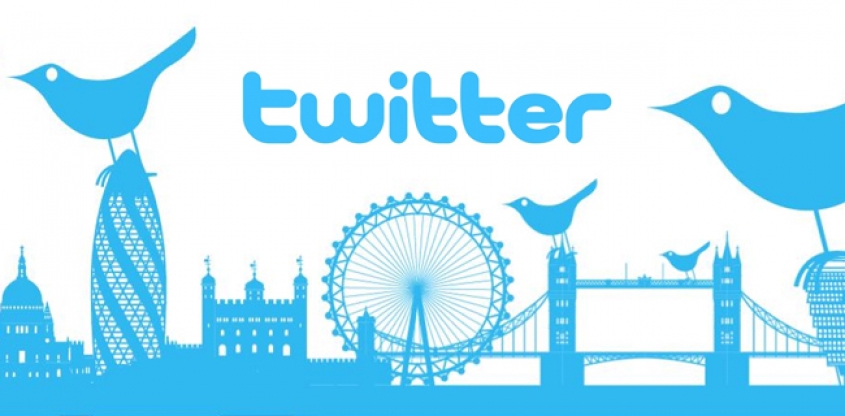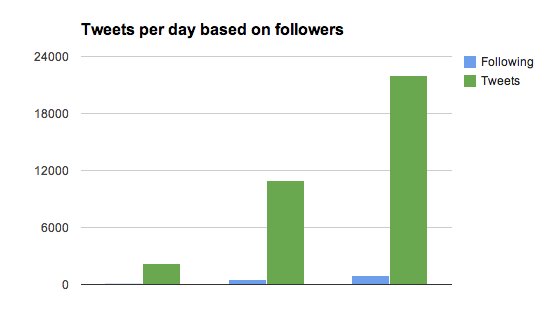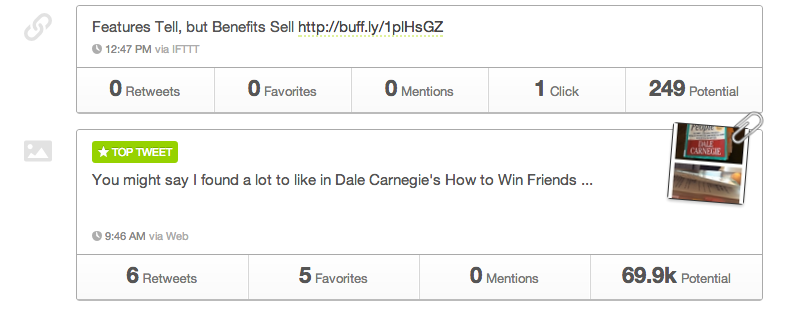Twitter Tips for Dummies: What I Should Know When I Started
- Transfer

Three weeks ago, my Twitter account was almost abandoned.
He existed in splendid isolation for several years as a distraction from work, when the latter allowed me to find the time to tweet. And so, three weeks ago this day came, and I rushed into the pool with my head, applying all the knowledge about Twitter that was in my arsenal. And even though I took a good start at the start, I still had a lot to learn.
Knowledge is rarely a substitute for experience. So while I was experimenting and chemical in every way, trying to figure out Twitter on my first few weeks of communicating with the service, I noticed that many things can only be learned in practice. In this article I will talk about the most important of them. So, meet: useful tips on Twitter for dummies.
1. You are not required to read every tweet.
If you have 100 followers, they will post about 2,200 tweets daily.
500 followers = 10 thousand tweets daily.
1000 followers = 22 thousand tweets daily.

In other words, since the length of tweets is an average of 30 characters, a person with 1000 followers will see so much content during the day that he could be four times the size of George Orwell's Animal Farm *.
You are not required to read every tweet. Instead of this…
2. Add your favorite users to a separate list.
Fortunately, I discovered the lists.
For me, the main advantage of lists is that I see the most important and original content from selected user groups. There is no sponsored content. In fact, we are dealing with a kind of minimalist version of Twitter.
My interests are very diverse, so I create different lists. I have a list for digital marketing, for New England Patriots and many other lists. This is a good alternative to combing the entire tape.
3. Always answer everyone and everything.
When people retweet your tweets, mention you in their posts, or add your posts to your favorites, they are looking for a connection with you. To some extent, this can even be called honorable. Someone rated your profile so highly that he wanted to contact you - it's a kind of honor.
One of the most popular brands on Twitter - the @notebook account - pays great attention to user responses.
“Regardless of whether you run an international brand like Nike or a local grocery store, it’s very important to thank every subscriber who asks you a question, gives you a compliment, or addresses a problem. Some will reply to you, while others will retweet your answer because they would like to show their friends that you are communicating with them. ”
4. Use a scheduler application like Buffer.

Here we come to the rescue tools for working with social networks. With Buffer, I can select the good content that I want to share (including retweets) and add it to the queue, thanks to which you can divide the content into portions for publication throughout the day at the most suitable time. I can control this process as I wish, and later I can monitor the statistics of which of the tweets were the most popular.
5. Provide information about yourself correctly.

By default, I always want to write something original about myself. I like Twitter pages that make me laugh. But what seems witty to me may not be so for anyone else. So instead of a funny biography, I had to write something more informative, leaving my creative ego aside.
6. Communicate directly with others.
“When you find a common language with other people and start communicating with them, you will immediately make friends on Twitter, and this will make your experience with the service even more enjoyable.”
The best method for me in this regard is to compose my own tweets. Every time I give a link to new content or share any information received from someone else, I mention the author (using the standard @ symbol) or the originator, or “HT” (or hat tip, which in this context can be translate as a thank you "for the tip" to another user - approx. translator). In other words, I do justice where necessary. Very often people appreciate it.

It turns out that I did not know the first rule for writing tweets: if you want everyone to see your tweet, do not start it with the @ symbol.
Twitter regards such tweets (and in most cases this is true) as private tweets addressed to a specific user. Only the user who posted the tweet, the recipient, as well as the followers of both accounts will be able to see such posts in their feeds.
This information has greatly influenced my behavior. I was nervous posting tweets with @ -responses to other users, since I didn’t want to fill out the feeds of my followers with tweets that might be uninteresting for them. Knowing that such tweets are away from the main stream, I felt much more comfortable.
7. Posting the same thing is not shameful.
Belle Beth Cooper wrote an excellent article debunking all the myths about reposting the same content. She gives three main reasons why you should do this:
- Getting More Traffic
- Covering multiple time zones
- Access to new followers
Knowing that there is nothing wrong with republishing the same content relieves stress when selecting content for posts. If I found a cool link, then I should not worry that I already tweeted it. Reposting can also be a great thing!
8. Forget the Following / Followers ratio and just subscribe to standing accounts.

Whatever the ideal ratio, I discovered for myself that the pursuit of it does not bring any benefit at the very beginning of the life of the account.
I joined Twitter to find new people, which I did.
My stumbling block was that I was haunted by the Following / Followers ratio in the accounts of top Twitter users. Part of me wanted me to have the same cool ratio, saying that I have a army of thousands of subscribers, while I myself am a subscriber to only a handful of accounts. For someone who just joined Twitter, it was pretty selfish.
The ideal ratio can wait. In the meantime, I made it a rule to become a subscriber to those who subscribed to receive updates to my account.
Selectivity can negatively affect your growth. According to KissMetrics, the fastest way to recruit subscribers is to become a subscriber to as many accounts as possible.
This method adds an individual approach, regardless of your popularity on Twitter. It shows that you noticed the emergence of a new follower and took the time to become his follower.
The truth is that the best Following / Followers ratio does exist, hidden in the secret depths of Twitter algorithms. When you become a subscriber to 2000 accounts, you will not be able to continue subscribing to new ones if your ratio does not meet certain requirements. I'm still far from the 2000 figure, but when I get close to that number, tools like Followerwonk will be super useful.
Lastly, the best tip I've heard on Twitter.
"Do not write about yourself, write about them."
And what advice would you like to receive at the very beginning of your communication with the service?
* Official math: 22,000 tweets of 30 characters each = 660,000 characters daily. Given an average of 5 letters per word, 660,000 letters are 132,000 words. An “animal farm” has about 30,000 words.
